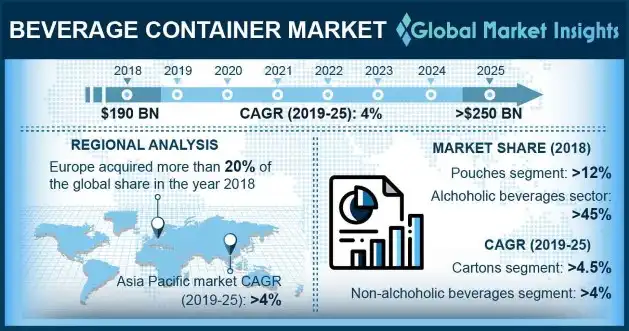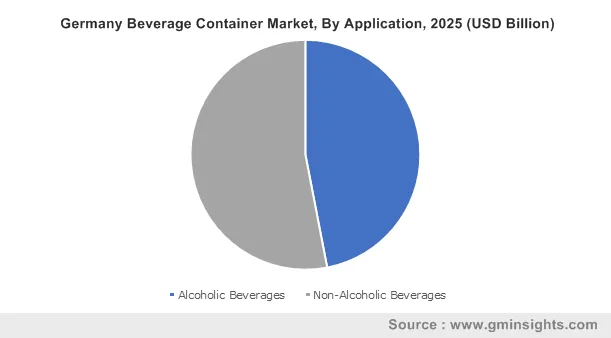Home > Packaging > Industrial Packaging > Industrial Wrapping and Protection > Global Beverage Container Market
Global Beverage Container Market Size
Global Beverage Container Market size was valued at over USD 190 billion in 2018 and is anticipated to witness over 4% CAGR up to 2025.

Rinsing consumer preference for single serving containers coupled with constantly changing food industry landscape is expected to drive beverage container market growth. Demand growth can be attributed to container features such as protection from the external environment, product support, and resistance to product tampering. Propagation of see-through cans and bottles for enhancing the aesthetic appeal of beverages such as fruit juices, sports & energy drinks, and enhanced water will support business growth. Additionally, new product launches accompanied by aggressive marketing campaigns are anticipated to accentuate the industry growth over the forecast period.
Changing consumer preferences have led to the use of novel container materials to retain the aroma, enhance strength, provide thermal stability, protection against moisture and ensure recyclability. Increasing demand for small flexible containers provides new avenues for business expansion. Incorporation of novel packaging techniques will also help the market to gain noteworthy momentum. For instance, aseptic beverage packaging has witnessed high demand in the beverages industry as it improves the shelf life of the product by preserving its nutritional & organoleptic properties.
| Report Attributes | Details |
|---|---|
| Base Year: | 2019 |
| Market Size in 2019: | 190 Billion (USD) |
| Forecast Period: | 2019 to 2025 |
| Forecast Period 2019 to 2025 CAGR: | 4% |
| 2025 Value Projection: | 1.4 Billion (USD) |
| Historical Data for: | 2014 to 2018 |
| No. of Pages: | 350 |
| Tables, Charts & Figures: | 732 |
| Segments covered: | Material, Container Type, Application and Region |
Beverage manufacturers are expected to incorporate aesthetic beverage packaging as it is visually appealing and attracts consumer attention towards their products. Recyclable container materials such as aluminum and PET for packaging beverages have been a popular choice of manufacturers over the last few years. Also, plant-based material has become a popular choice among beverage manufacturers as it helps them to reduce their carbon footprint. For instance, In June 2018, So Delicious announced the launch of their organic almond milk in a 48-oz bottle made from bio-based plastic which offers the same benefits as traditional packaging while also ensuring its recyclability.
Growing concerns regarding the use of plastics and risk related to metal particles contaminating the products have led manufacturers to adopt paperboard for packaging of various beverages. For instance, WestRock Company announced the launch of paperboard can for the packaging of their energy drinks product line. Favorable policies and standards pertaining to the usage of packaging materials are expected to remold the overall industry landscape. For instance, FDA regulates packaging materials under section 409 of the federal food, drug and cosmetic act with an aim to nullify the negative effect of material on edible products.
The stringent environmental regulations are expected to create a hindrance to industry growth. For instance, the “European Parliament and Council Directive 94/62/EC on packaging waste” ensure that adequate steps are taken by manufacturers to counter industrial waste and increase recyclability. Other challenges faced by manufacturers are the declining soft drinks and alcohol sales over the last few years and the sluggish growth in other soft drinks’ markets in the last 5 years, which have hampered the growth of this market.
Global Beverage Container Market Analysis
Glass is among the fastest growing segments in the global beverage container market. The capability of glass to preserve strength, aroma, and flavors of beverages makes it the most preferred option for the alcohol industry. The material is 100% recyclable, thereby making it a desirable packaging option from environment point of view. Six tons of recycled glass indirectly saves six tons of substitute resources and reduces CO2 emission by one ton. The material is odourless, chemically inert and provides resistance to gases and vapours.
Paperboard segment offers benefits including lightweight, low cost, easy handling, high strength to weight ratio, and recyclability. The environmentally friendly nature of this material has widened its scope of use for all types of beverages including fruit, caffeine, energy, carbonated, etc. Growing focus towards the use of recycling materials along with improving the flexibility and presentation of packaging has enhanced the use of this material across myriad beverage packaging segments.
Cartons are anticipated to witness over 4.5% gains from 2019 to 2025. Cartons enable safe storage and transportation of beverages and provide customized packaging based on the manufacturer’s marketing requirements. Cartons have an extended shelf life, minimal wastage, and convenience, which are among the key reasons responsible for sustained beverage carton sales on a global level. Customers are increasingly opting for biodegradable and eco-friendly packaging, which is likely to cause beverage manufacturers to shift their focus from conventional packaging solutions. Additionally, government support for the use of container materials with low carbon footprint will significantly propel the demand for beverage cartons.
Pouches accounted for more than 12% share in the overall beverage container market. The increasing popularity of pouches due to its flexibility and easy to handle nature will support segment growth. Pouches are available in a variety of size, shapes, and color and are immensely popular among children. Flexographic printing, shape & structure, cost reduction, and convenience are certain key factors that will contribute towards segment growth over the forecasted timeframe.
Alcoholic beverages accounted for more than 45% share in the overall beverage container market. Alcohol beverage container play a major role in the brand promotion of alcohol. Increasing global consumption of alcoholic beverages and focus on recycling are the two major factors driving the segment growth. Major manufacturers in the industry are developing containers, with an aim to safeguard the alcohol properties for a longer period. This has increased the demand for sustainable materials which will promulgate beverage container market.

Non-alcoholic beverage consumption will witness gains at over 4% up to 2025. Growing popularity of non-alcoholic drinks such as energy drinks and fruit juices will proliferate overall beverage container market. The inclination of the customers towards attractive and sustainable packaging options for their beverages is expected to bolster the product penetration in this segment. Additionally, rising consumer awareness regarding the use of sustainable materials have led the manufacturers in this segment to adopt organic materials for packing their beverages. This will give an impetus to the industry growth.
Asia Pacific is expected to witness a growth of more than 4% by 2025. The changing consumer preferences coupled with high growth in economies including India, China, Indonesia, Malaysia, and Indonesia are driving the beverage container market in this region. The industry is expected to witness a surge owing to high demand for glass bottles from the alcoholic beverage industry. While the growth of the non-alcoholic beverage containers is largely driven by growth in consumption of fruit beverages and packaged water.

Europe accounted for more than 20% share in the overall beverage container market. The ready availability of natural resources coupled with improved production facilities and low-cost labor will escalate the beverage container market growth. The European beverage container market is largely driven by changing consumer preference and the need for prolonged shelf-life of beverages. However, government regulations along with a ban on certain materials used for manufacturing containers might lay cost pressures on manufacturers and are few of the factors that hinder the market growth.
Global Beverage Container Market Share
Global beverage container market is highly competitive owing to the existence of large market players operating comprehensively. Key industry players include
- Amcor Limited
- Ball Corporation
- Rexam Inc.
- Silgan Holdings
- Owens-Illinois
- Toyo Seikan Group Holdings
- CLARCOR
- Huber Packaging Group
- Ardagh Group
Mergers & acquisitions, product innovation, and portfolio expansion are among the key strategies incorporated by industry participants for improving their market share. For instance, in February 2018, Ball corporation has announced its plans increase the capacity of its facility in Buenos Aires and build an integrated one-line can manufacturing plant in Paraguay. This expansion has allowed the company to meet growing beverage can market in Paraguay, Bolivia and Argentina and support customer demand with multiple can sizes.
Industry Background
Global beverage container market is driven by rapid technological development and innovations across the packaging industry. The beverage packaging industry is undergoing various changes that are expected to transform the face of the market. Varying geopolitical scenario and purchasing patterns of consumers have made it difficult for market player to capitalize upon market movements. Development of smart packaging solution that can interrelate with the product or its environment to improve the quality of beverages, customer acceptability, and safety are some of the key factors driving the global market.
Frequently Asked Questions (FAQ) :